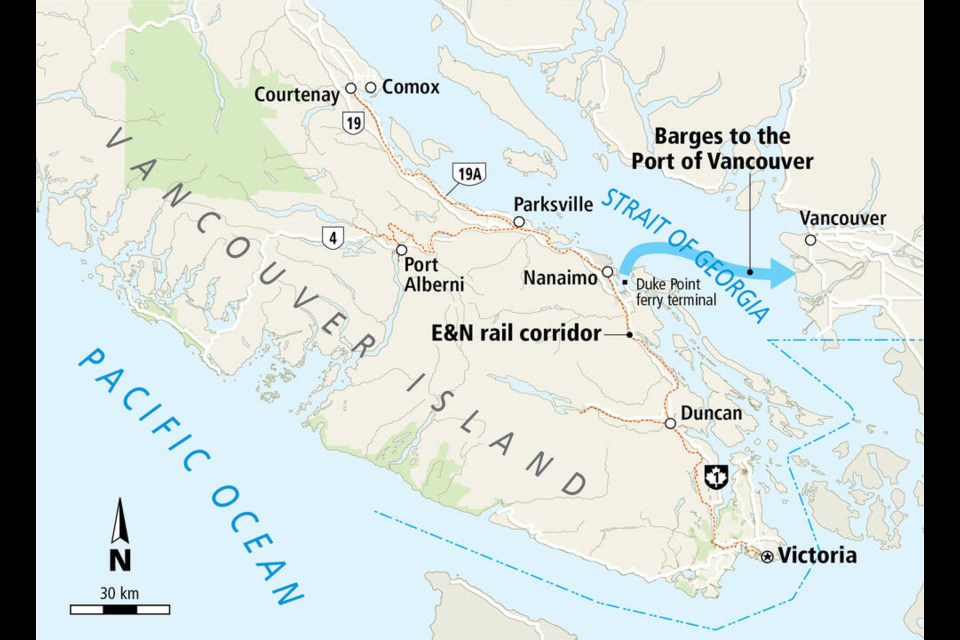A new company is proposing a partnership with governments and First Nations to establish a $1-billion modern freight rail service between ports in Port Alberni and Nanaimo, supported by barges carrying cargo to the Lower Mainland.
“Contemporary rail provides a cost-effective and environmental means to move cargo, people and support tourism,” said Dave Hayden, president of Island Rail Corp., who was previously in senior management with Canadian Pacific Railway.
The goal is to provide “seamless rail transport” from Port Alberni, with its deep sea port, to Nanaimo and then by barge over to the Lower Mainland, where there is direct access to North American rail networks, Hayden said Thursday.
Cargo would come into Port Alberni and be loaded onto rail cars. From there, the freight would be carried by rail to Nanaimo, where 50 cars, with two stacked containers each, could go straight onto a barge to the mainland, Hayden said.
The service would help ease congestion at the busy port in Vancouver.
Hayden said when the company spoke to potential freight customers on the Island, “the interest was phenomenal.”
“We did manage to chase the economics and come up with a viable option to make the project work financially.”
Island Rail Corp., headquartered in Victoria, is also exploring the possibility of bringing cargo from Mexico to Port Alberni and establishing new businesses there, Hayden said.
Along with the mid-Island freight service, it’s looking at carrying freight up and down the Island as well as running passenger service for locals and tourists. Parallel hiking and biking pathways would be incorporated, the company said.
From the start, the company wants to see corridor land ceded back to First Nations, Hayden said. Land was expropriated from First Nations in the early 1900s to develop the now shuttered E&N rail line.
The company doesn’t want to rely on the government for funding. “We wanted to incorporate or involve the private sector,” Hayden said.
Hayden said the proposal looks 100 years into the future.
Its first goal is to see land returned to First Nations and then an agreement would have to be reached with First Nations as a partner, he said. It’s not known how long that might take.
From that point, it would take about 30 months to get the railway operating, he said.
The ownership and operations of the railway is something that would be worked out with First Nations, Hayden said.
The proposal comes as the federal government dedicates $600,000 from the National Trade Corridors Fund for the Nanaimo Port Authority to study expanding container capacity at its Port Drive site, and to look into the development of land near the port to support economic growth, new jobs and trade.
The Port Authority will also examine expanding Nanaimo’s Duke Point Terminal to help alleviate the bottleneck at Vancouver’s deep-sea terminals.
Key to the study is assessing potential improvements to transporting cargo by sea over short distances — such as Nanaimo to the Lower Mainland.
The federal government says that could improve import and export capacity of sectors such as forestry, agriculture and seafood.
Rail watchers were expecting a decision this week on whether the federal government would put money into a revived railway service between Courtenay and Victoria.
The B.C. Court of Appeal had set March 14 as a deadline for the government to announce its intentions following a lawsuit from the Snaw-Naw-As First Nation at Nanoose. The nation went to court to seek return of land expropriated for the rail corridor.
Instead of making a definitive announcement about the future of rail on the Island, the federal and provincial governments said 10-plus acres would be returned to the Snaw-Naw-As Nation. The province also pledged $18 million for consultations with First Nations.
>>> To comment on this article, write a letter to the editor: [email protected]



